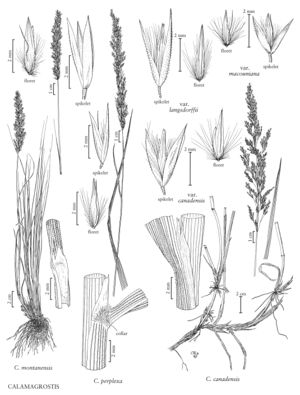Calamagrostis canadensis var. langsdorffii
Culms (32) 65-110 (180) cm, often branching above the base, smooth or slightly scabrous beneath the panicles; nodes (2) 3-5 (8). Sheaths and collars smooth or scabrous; ligules (3) 5-8 (12) mm; blades (11) 18-29 (50) cm long, (2) 3-7 (11) mm wide, adaxial surfaces usually strongly scabrous, rarely smooth, often glaucous. Panicles (6) 9-15 (25) cm long, (1.5) 2.5-4 (8) cm wide, often contracted when young, usually purplish, sometimes greenish to straw-colored; branches (2.7) 3.5-6 (12) cm. Spikelets (3.5) 4-4.5 (5.2) mm; rachilla prolongations 0.7-1 mm, hairs 2-3 mm. Glumes keeled, usually scabrous throughout, rarely smooth, prickles on the keels hairlike, often bent, lateral-veins obscure to prominent, apices acuminate; callus hairs (1.5) 3-3.3 (4.5) mm, (0.5) 1-1.2 (1.5) times as long as the lemmas; lemmas (2.3) 2.5-3 (4) mm, 0.4-2.1 mm shorter than the glumes; awns 1.2-3.1 mm, attached to the lower (1/10) 1/5 – 2/5 (1/2) of the lemmas, not exserted, usually straight; anthers (0.9) 1.2-1.6 (2.6) mm. 2n = 28, 42, 56.
Distribution
N.H., Minn., Colo., Wash., N.Y., Alaska, Alta., B.C., Greenland, Man., Nfld. and Labr., N.W.T., Nunavut, Ont., Que., Sask., Yukon, Oreg., Mont., Vt., Ga., Calif.
Discussion
A circumboreal taxon, Calamagrostis canadensis var. langsdorffii grows from Alaska to Greenland and south to northern California, Colorado, Minnesota, New Hampshire, and New York.
Selected References
None.
Lower Taxa
"decumbent" is not a number.
